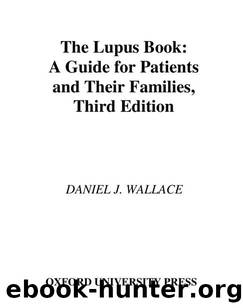The Lupus Book: A Guide for Patients and Their Families, Third Edition by Daniel J. Wallace

Author:Daniel J. Wallace [Wallace, Daniel J.]
Language: eng
Format: epub
Published: 0101-01-01T00:00:00+00:00
when he or she doesnât have the disease. Occasionally, I come across what I
can only call a ââlupus wanabee.ââ These individuals are convinced they have
the disease on the basis of reading and talking to their friends. It is very difficult to convince them that they donât. Some want to be diagnosed as having lupus
perhaps for psychological reasons: they want loved ones to pay more attention
to them or feel sorry for them, or they want to prove to family members that
they are not ââcrazy.ââ Some may eventually find a doctor who will agree with
their self-diagnosis and treat them. But this is not the sort of illness that can be placated with innocuous and harmless treatments. The therapy for SLE involves
toxic, expensive, and time-consuming treatment. Disease-modifying therapies
(anything other than an NSAID) should never be given unless a firm diagnosis
[172]
Where and How Can the Body Be Affected by Lupus?
has been made or an organ-threatening complication is clinically evident. La-
beling a patient with SLE who does not have the disease can make it difficult
for him or her to obtain gainful employment, health insurance, or life insurance and can mean lifelong stigmatization.
WHAT IS ANA-NEGATIVE LUPUS?
Heidi was sure she had lupus even though six different doctors had obtained
six different negative ANAs in six different labs. She had a butterfly rash
on her cheeks, was tired and achy, and had a checkerboard mottling (called
livedo reticularis) on her legs. Finally, the third rheumatologist she saw
was sympathetic to her predicament. Even though her blood chemistry pro-
files, chest x-ray, electrocardiogram, sedimentation rate, CPK, anti-DNA,
and complement levels were negative or normal, Dr. Schwartz obtained
additional blood for testing. Heidi had a positive anticardiolipin antibody
and a false-positive syphilis serology. These antibodies are seen in 20 per-
cent of discoid lupus patients and are associated with livedo reticularis. Dr.
Schwartz also referred Heidi to a dermatologist, who did a lupus band test
on her cheek rash; it came back positive. A bone scan showed increased
blood flow to her hands and feet, suggesting an inflammatory arthritis. Dr.
Schwartz diagnosed Heidi as having ANA-negative lupus since she fulfilled
the criteria by having arthritis, sun sensitivity, discoid rashes, and a false-
positive syphilis serology. Three years later, Heidiâs ANA blood test be-
came postive.
Until 1985, 10 percent of all lupus patients had a negative ANA test. The
introduction of improved testing material for performing the ANA test has de-
creased this percentage to 3 percent. Between 1980 and 1989, my office treated
464 patients who fulfilled the ACR criteria for lupus; seventeen of them were
ANA-negative. In analyzing this group, we found that patients fell into four
basic categories. One-third had antiphospholipid antibodies and one-third had
biopsy-documented kidney lupus. Of the remaining third, half ultimately became
ANA-positive. The last group had advanced disease; prolonged treatment with
steroids and chemotherapy made their ANA disappear. A variety of rarer causes
of ANA-negative lupus exist, such as the presence of anti-Ro (SSA) antibody
without ANA. Nevertheless, if a patient does not fall into any of these four
categories, some of the lupus-related or lupus-mimicking disorders discussed in this chapter might be the culprit.
WHAT IS AN UNDIFFERENTIATED CONNECTIVE TISSUE
DISEASE (UCTD)?
Many
Download
This site does not store any files on its server. We only index and link to content provided by other sites. Please contact the content providers to delete copyright contents if any and email us, we'll remove relevant links or contents immediately.
When Breath Becomes Air by Paul Kalanithi(7253)
Why We Sleep: Unlocking the Power of Sleep and Dreams by Matthew Walker(5637)
Paper Towns by Green John(4163)
The Immortal Life of Henrietta Lacks by Rebecca Skloot(3820)
The Sports Rules Book by Human Kinetics(3581)
Dynamic Alignment Through Imagery by Eric Franklin(3482)
ACSM's Complete Guide to Fitness & Health by ACSM(3459)
Kaplan MCAT Organic Chemistry Review: Created for MCAT 2015 (Kaplan Test Prep) by Kaplan(3418)
Introduction to Kinesiology by Shirl J. Hoffman(3297)
Livewired by David Eagleman(3115)
The River of Consciousness by Oliver Sacks(2989)
Alchemy and Alchemists by C. J. S. Thompson(2908)
The Death of the Heart by Elizabeth Bowen(2896)
Descartes' Error by Antonio Damasio(2728)
Bad Pharma by Ben Goldacre(2722)
The Gene: An Intimate History by Siddhartha Mukherjee(2488)
Kaplan MCAT Behavioral Sciences Review: Created for MCAT 2015 (Kaplan Test Prep) by Kaplan(2483)
The Fate of Rome: Climate, Disease, and the End of an Empire (The Princeton History of the Ancient World) by Kyle Harper(2429)
The Emperor of All Maladies: A Biography of Cancer by Siddhartha Mukherjee(2427)
